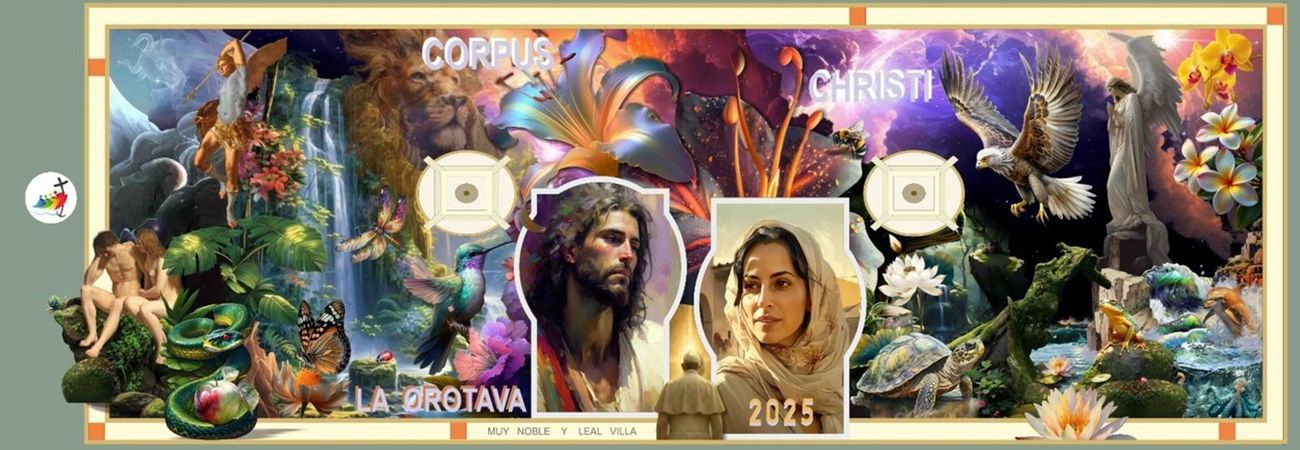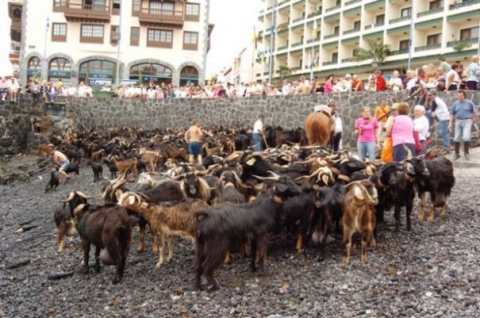Puerto de la Cruz
FIESTAS OF EL GRAN PODER AND LA VIRGEN DEL CARMEN
Whilst the procession of El Gran Poder is parading through the more stately streets of Puerto de la Cruz, to the military rhythm of trumpets and drums, the El Carmen procession follows the streets of the fishermen. La Virgen del Carmen is taken out of the church of La Peña de Francia and carried in procession, along with San Telmo, in the midst of compliments and songs that the fishermen dedicate to her. Before the figures go on board a fishing vessel, a flock of doves are released. In the end there is a grand fireworks display on the fishing pier.The figures of the Saints are then taken back to their mother church.
Embarkation of Our Lady of Mount Carmel (Virgen del Carmen)
This Marian devotion was spread by Pope Benedict XIII to the Universal Church in appreciation of a Religious Order, the Carmelites, who were deeply Marian and considered Our Lady of Mount Carmel as mother and sister. It has its origin to the south of the current Port of Haifa, in Palestine, where Mount Carmel rises, dominating the Mediterranean sea. During the time of the Crusades, around 1156, some pilgrims and soldiers decided to settle there and this is where the order takes its name, Carmel, which means "Garden". Patronage by the seafarers was late, in 1901, and in fact it was not until 1922 when the priest of the Peña de Francia proposed that the seafarers and fishermen move to Los Realejos saying, "why not bring Our Lady of Mount Carmel to Puerto de la Cruz?". The statue arrived in 1923 after a sea and land journey, but the seafarers continued visiting, and taking out, the Lady of Carmel in Realejos. The present and characteristic Lady of Mount Carmel was done in 1954 by sculptor Angel Acosta.
FIESTAS OF EL SOL OR SAN JUAN
These fiestas are held on the fishing docks, among crowds of locals and tourists. Everyone sets up camp on the Playa del Charcón and the Playa del Muelle, waiting for the sun to come up, in order to witness the famous "baño de las cabras" (goat dip) which is held on the day of San Juan every year, in memory of an aboriginal fiesta held by the Guanches to celebrate the summer solstice. Goat herds offer cheese and milk to all and sundry, many take a dip and everyone sees in San Juan's day with dancing.
FIESTAS OF SAN ANDRES
This fiesta is commonly called "La Fiesta del Cacharro" (pots) or "La Castaña" (chestnut). On the evening of November the 29th, young people and tourists gather in Plaza del Charco to throw hundreds of pots and pans, and other old objects, around. They bang them on the ground, making quite a din as they move along the adjacent streets. The "Castañada" (chestnut feast) is held in the square itself, with the chance to try many typical products of the island, like chestnuts, wreckfish, toasted corn flour, sweet potato, wine, etc.
FOUNDATIONAL FIESTAS
FOUNDING FESTIVAL / FESTIVAL OF THE CROSS
On 3 May the town's Founding Festival takes place, celebrating the day on which, in 1651, the first district mayor was sworn into office. The day begins with a formal church service, followed by the procession of the Silver Cross (the town's co-patron, along with Our Lady of la Peña de Francia), which is accompanied by bangers and fireworks along its route. In the afternoon it is traditional to visit one of the numerous chapels dedicated to the Holy Cross (there are more than 30 in and around Puerto de la Cruz) in order to admire the floral decorations on display throughout the day. Also of note are the M-shaped shrouds, some of which are extremely old, made from fine, gold-embroidered cloth, painted, or simply left blank as a symbol of purity.
In municipalities like Puerto de la Cruz, the practice of venerating the cross has acquired an extremely important ethnographic and religious dimension. The ritual has its origins in the individual crosses that were found in each home, and later transferred onto the larger wooden crosses found in chapels, hermitages and at crossroads.
The close relationship between the town and the cross is documented from the earliest days of the conurbation, which over time consolidated its political and administrative separation from the municipality of La Orotava (of which it was a part until the early 19th century).
It is said that the cross which gave its name to the town was the one located on the side of the façade of the Customs House. That cross, along with around 30 others that appeared in various private homes, chapels and hermitages around the town, form a Via Crucis, or Stations of the Cross. On the day of the festival they are festooned with a variety of decorations ranging from a selection of local flora to the artistic originality of the so-called "Green Cross" in Calle Mequinez, which is decorated with extraordinarily realistic flowers made from fish bones and scales.
There are several reasons as to why the crosses were positioned around the town: as mentioned above, some of them were placed in accordance with the Stations of the Cross, symbolising the different parts of Jesus's journey to the Golgotha; others were placed in order to commemorate a violent death or accident; and some were positioned in order to mark a crossroads or the town boundary. Some crosses were also put in place in order to mark specific geographical locations, such as summits or crags.
Fiestas to celebrate the foundation of the city are held on the 3rd of May, with a solemn mass followed by a procession, with La Cruz de Plata (Co-Patron Saint of the town, along with La Virgen de Nuestra Señora de la Peña de Francia) in the midst of spectacular and deafening fireworks all along the processional route. Traditionally, the people spend the afternoon visiting the many chapels devoted to Santa Cruz, of which there are more than thirty in Puerto de la Cruz, to admire the floral decorations that will remain on display throughout the year.








